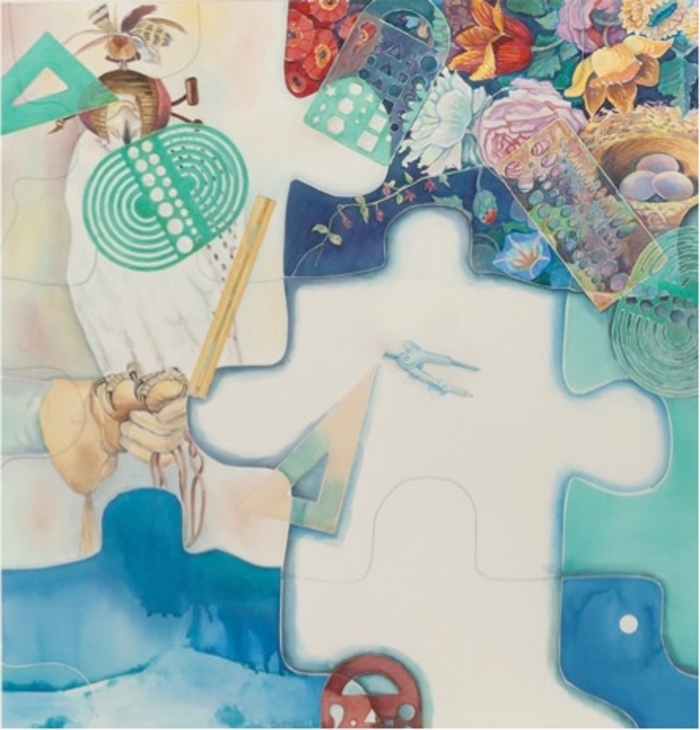Public Art on Campus - James Drake
ART ON CAMPUS
Raptor: Order and Disorder
Year: 1996
Medium: Watercolor on Paper
Location: Education Building, 1st Floor
Gift of Rob Clark and Jerry Thacker
Ken Dixon began his “Order and Disorder” series in 1986. His goal is to present the viewer with a set of incompatible images and an invitation to solve a puzzle. In direct reference to this challenge, Dixon designed “Raptor: Order and Disorder” to look like a giant jigsaw puzzle complete with the recognizable interlocking knobs and notches of puzzle pieces. At first glance, the painting appears to be a colorful, somewhat decorative work of art, but upon closer inspection, it is evident that Dixon is teasing us with a number of confusing images and styles. What does the bird have to do with the drafting tools? Why don’t the colors and imagery of the individual puzzle pieces transition from one to the other? Why do some of the tools, like the triangle, appear to be tucked beneath a puzzle piece, while others rest on top?
Consider the falcon perched on the glove of its handler. The falcon is wearing a leather hood indicating it is being trained to hunt - a prime example of nature being tamed by a human. Superimposed over the falcon, and strategically placed elsewhere around the painting, are various drafting tools: a triangle, ruler, compass, and several templates. All are common utensils used by architects, designers, and engineers to create schematics that bring order to a technical drawing or plan. The upper right corner of the painting contains colorful images of flowers and a nest or basket holding three eggs. The stylized rendering brings to mind a floral wallpaper pattern. Dixon is asking us to ponder the contrast between untamed nature and the ordered, manufactured nature we use to decorate our homes.
Another intriguing paradox is the use of different styles within the same painting. The top half is painted with great detail while the center is almost devoid of color or imagery. The bottom left is painted so loosely that the watercolor flows and drips as though a dark blue cloud is raining down upon a light blue mountain peak. Dixon is known for mixing styles and leaving some areas looking unfinished. Perhaps the sole purpose is to emphasize opposites, or maybe Dixon is referencing his interest in quantum physics. What we perceive as a solid surface is an illusion that hides the constant movement of particles at a subatomic level.
Throughout the painting, the various shades of blue tie the composition together and create a sense of balance. Pops of color keep the eye moving around the painting, particularly over the neutral areas. Dixon proves himself a master of design with his ability to tie disparate images and styles together to create a cohesive whole. The end result is an overall visually pleasing artwork that illustrates his objective of bringing order to disorder



